Brent Goose Identification
The brent goose complex is a fascinating one, though can be quite frustrating at times. There are four races of the brent goose that visit Ireland and the UK. These include the Pale, dark, grey-bellied and black brant. I have decided to take on this identification piece to try and make it somewhat easier to get to grips with these winter visitors. Ireland is one of the best countries to find large flocks of wintering brent. This leads to each of the races finding their way to Ireland most years. Adding an identification challenge for Irish birders. In this identification piece I hope to make the task of the brent goose complex a little easier and perhaps even enjoyable!
I find by adding more images than text the brent goose complex maybe made a little easier to get to grips with.

Pale-bellied brent flock - Mark Collins
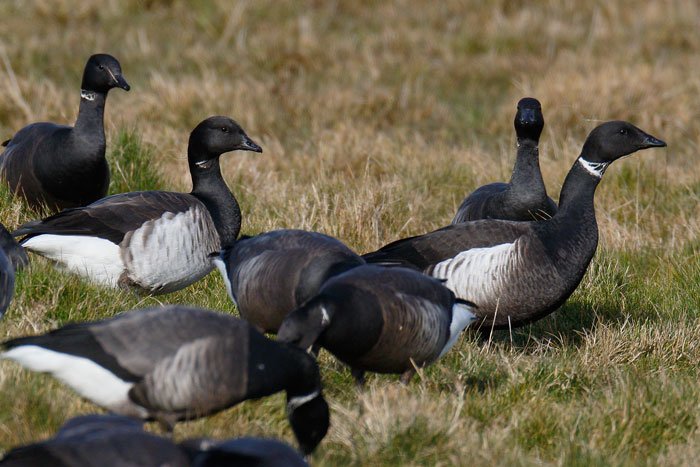
Adult pale, dark-bellied and black brant - Steve Ganlett
An image to delve straight into the the brent/brant identification complex. As an Irish or British birder, we would be familiar with both the pale and dark-bellied races. Though the darker of the birds (right hand bird) may be new to some. This bird is known as the black brant, a rare winter visitor from North America. Which mixes in flocks of both pale and dark-bellied brent in Ireland and the UK.
I find by adding more images than text the brent goose complex maybe made a little easier to get to grips with.

Pale-bellied brent flock - Mark Collins

Adult pale, dark-bellied and black brant - Steve Ganlett
An image to delve straight into the the brent/brant identification complex. As an Irish or British birder, we would be familiar with both the pale and dark-bellied races. Though the darker of the birds (right hand bird) may be new to some. This bird is known as the black brant, a rare winter visitor from North America. Which mixes in flocks of both pale and dark-bellied brent in Ireland and the UK.
Pale (light) -bellied brent:
The pale-bellied brent goose is the most common visitor to Ireland each winter. And is one of the most regularly seen goose species to be seen by birders. These winter visitors migrate from high arctic Canada each year. They occur from October to April. Though there are often occasional birds that can be found during the spring and summer. These individuals may perhaps be sick or injured. The pale-bellied brent is probably the most variable of the brent taxa in terms of plumage.
Key Features:
First-winters: Show a range of juvenile features on the head, upper-parts and underparts, wing coverts and tertials. The scally upper-parts are a key feature of identifying immature brent. Some first-winter birds can appear rather grey/brown on the underparts, though tend to be paler above than that of a first-winter Dark-bellied (Such birds can often cause confusion).
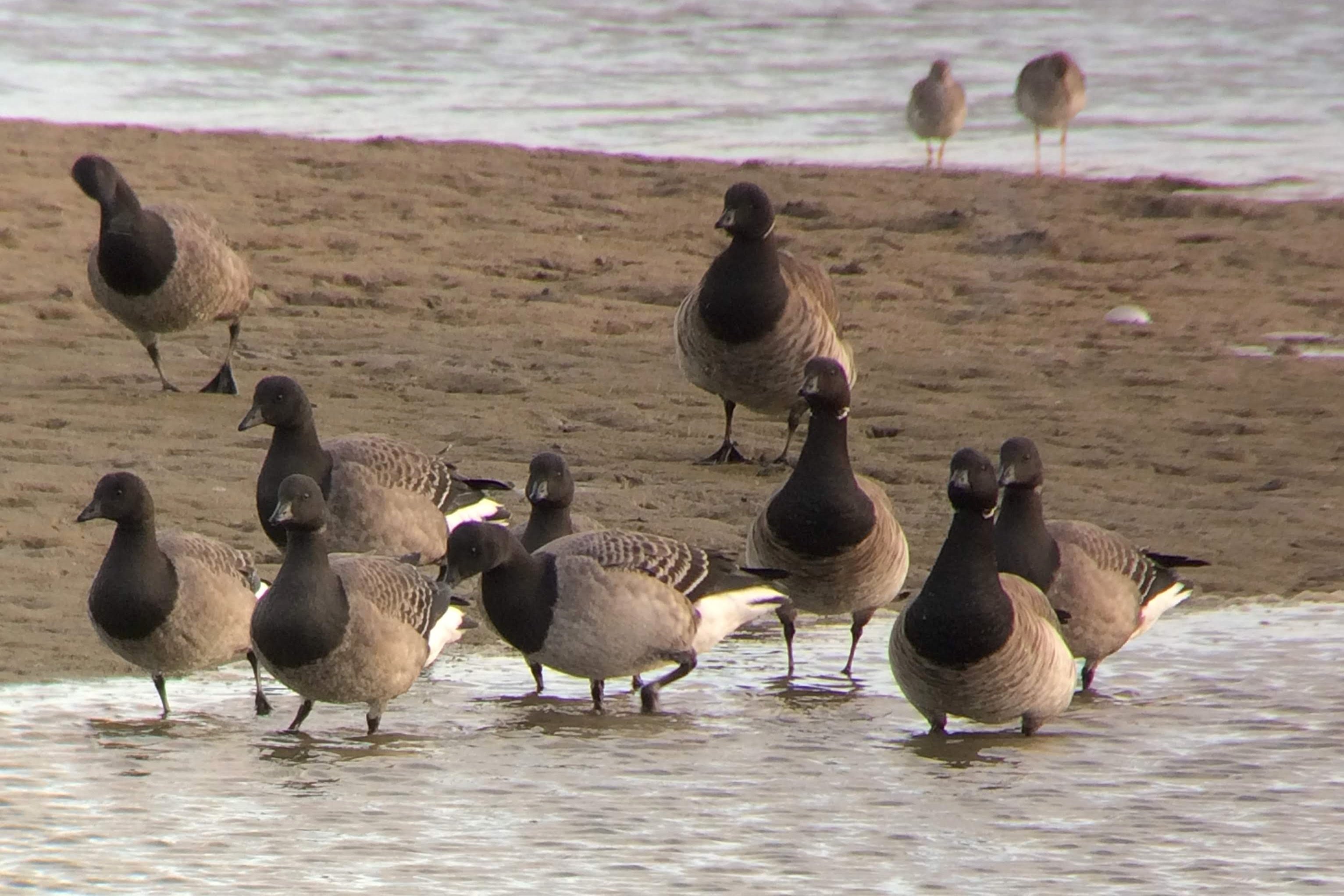

First-winters and adults pale-bellied - Jan Rod
A flock of grey washed first-winter and adult pale-bellied. These first-winter birds are still in very much juvenile plumage. The upper-parts show juvenile scapulars and wing coverts with areas of cream/white markings unlike the whiter markings of a more advanced first-winter. There is quite a substantial difference between the under-part tone among these first-winters. Some showing a pale light grey wash, others a slightly darker more extensive grey wash.

A flock of mostly first-winter Pale-bellied brent - Mark Collins
A flock of grey washed first-winter and adult pale-bellied. These first-winter birds are still in very much juvenile plumage. The upper-parts show juvenile scapulars and wing coverts with areas of cream/white markings unlike the whiter markings of a more advanced first-winter. There is quite a substantial difference between the under-part tone among these first-winters. Some showing a pale light grey wash, others a slightly darker more extensive grey wash.

A flock of mostly first-winter Pale-bellied brent - Mark Collins
Adults: Grey/brown upper-parts, black head and neck, thin collar (Unlike brant), pale underparts (This can vary from pale with light grey to light grey running towards the under-tail coverts), clean white flanks.

Adult Pale-bellied brent - Janice Sutton
These birds are typical adult pale-bellied brent. Showing an all round pale plumage tone (Unlike that of the dark-bellied, grey-bellied and black brant)

Adult Pale-bellied brent - Jan Rod
A classic adult, which is both satellite tagged and ringed. This bird shows a classic thin neck collar, grey/brown upper-parts and pale underparts which are not extending into the under-tail coverts.

First-winter and adult flock of Pale-bellied brent - Colin Leslie
In the above image it is clear to see the differences in both first-winter and adult pale-bellied. The scaly upper-parts of the first-winters is very striking with the white fringing to the scapulars and wing coverts. While adult birds show a more uniform upper-part feather complex.
These birds are typical adult pale-bellied brent. Showing an all round pale plumage tone (Unlike that of the dark-bellied, grey-bellied and black brant)

Adult Pale-bellied brent - Jan Rod
A classic adult, which is both satellite tagged and ringed. This bird shows a classic thin neck collar, grey/brown upper-parts and pale underparts which are not extending into the under-tail coverts.

First-winter and adult flock of Pale-bellied brent - Colin Leslie
In the above image it is clear to see the differences in both first-winter and adult pale-bellied. The scaly upper-parts of the first-winters is very striking with the white fringing to the scapulars and wing coverts. While adult birds show a more uniform upper-part feather complex.

Flock of adult Pale-bellied brent - Colin Leslie
Adult Pale-bellied brent - Jan Rod
This particular bird shows a grey wash to the breast and belly (Many pale-bellied show this grey wash). These grey washed individuals may often be confused with grey-bellied, though they do not show a broad neck collar or dark upper and under-parts like a grey-bellied.

Adult and first-winters Pale-bellied - Mark Collins
A good comparison of adult (foreground) and first-winter (background) pale-bellied brent. The white upper-part markings and light grey tone to the upper-parts of the first-winter compared to the adult.

Adult pale-bellied brent in flight - Mark Collins
In strong sunlight this adult pale-bellied brent shows very little areas on the belly that could cause any confusion of other subspecies. In this light, the under-wing also appears a lot paler than that of a black brant would.
Adult pale and Dark-bellied brent - Steve Ganlett
Dark-bellied brent goose:
The dark-bellied brent is a subspecies of the far more common pale (light) bellied brent. These scarce winter visitors are mainly found among wintering flocks of pale-bellied. This brent goose race is a vagrant from Siberia. Numbers of this subspecies tend to increase in March and April when large flocks of pale-bellied brent begin to gather before migrating back to arctic Canada. This leads to an increase in sightings of the Dark-bellied brent goose at coastal locations.
Key Features:
First-winter: Show juvenile feathering on the upper-and underparts, the head, neck and upperparts are paler than an adult dark-bellied, they show a set of juvenile wing coverts and tertials, the underparts are usually paler than an adult dark-bellied would be (Though this is quite highly variable). The neck collar is small and no were near as prominent as that of a grey-bellied or black brant.
Adults: They show a darker upperpart tone to pale-bellied (This can also be variable), though the upperparts are always a good indication while scanning through large flocks of pale-bellied, the head and neck is black, while the underparts are chocolate brown in colour which projects to the undertail coverts.

First-winter Dark-bellied brent - Jan Rod
A rather classic first-winter Dark-bellied, showing a brown wash to the neck which extends down to the breast and belly, brown wash to the flanks, brown can be seen just extending into the under-tail coverts (Note that this feature can be noted in pale-bellied). Browner upper-parts to pale-bellied.
A rather classic first-winter Dark-bellied, showing a brown wash to the neck which extends down to the breast and belly, brown wash to the flanks, brown can be seen just extending into the under-tail coverts (Note that this feature can be noted in pale-bellied). Browner upper-parts to pale-bellied.
Dark-bellied brent flock - Steve Ganlett
Adult Dark-bellied brent - Steve Ganlett
Black neck and upper-breast contrasting with the brown belly and under-parts. Grey sheen to the upper-parts.

Adult Dark-bellied brent - Jan Rod
This adult is a very distinctive individual, showing a darker grey/brown upperpart tone compared to the pale-bellied in the foreground. The flank area is mostly covered with this chocolate brown colouration which extends from the belly. Dark-bellied brent can often be quite aggressive while mixed with pale-bellied flocks. As can be seen in this image.
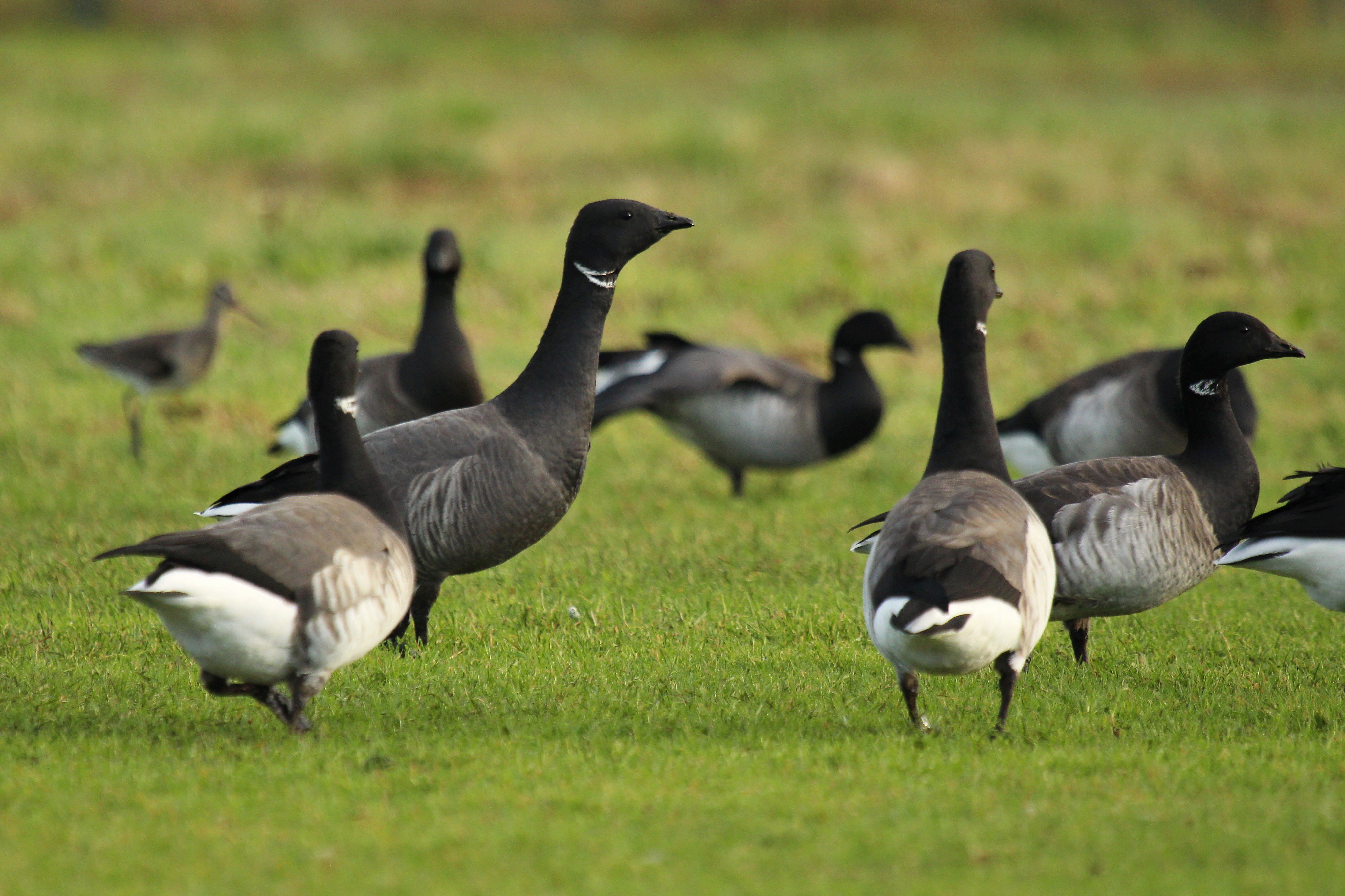
Same Adult Dark-bellied as above (Left) among Pale-bellied - Jan Rod
This is a very useful image that represents the differences between both subspecies. This adult dark-bellied brent is a very well marked individual. Many of the dark-bellied brent are not quite as well marked as this particular bird. While scanning through a large flock of pale-bellied birds this dark-bellied would be rather distinctive.
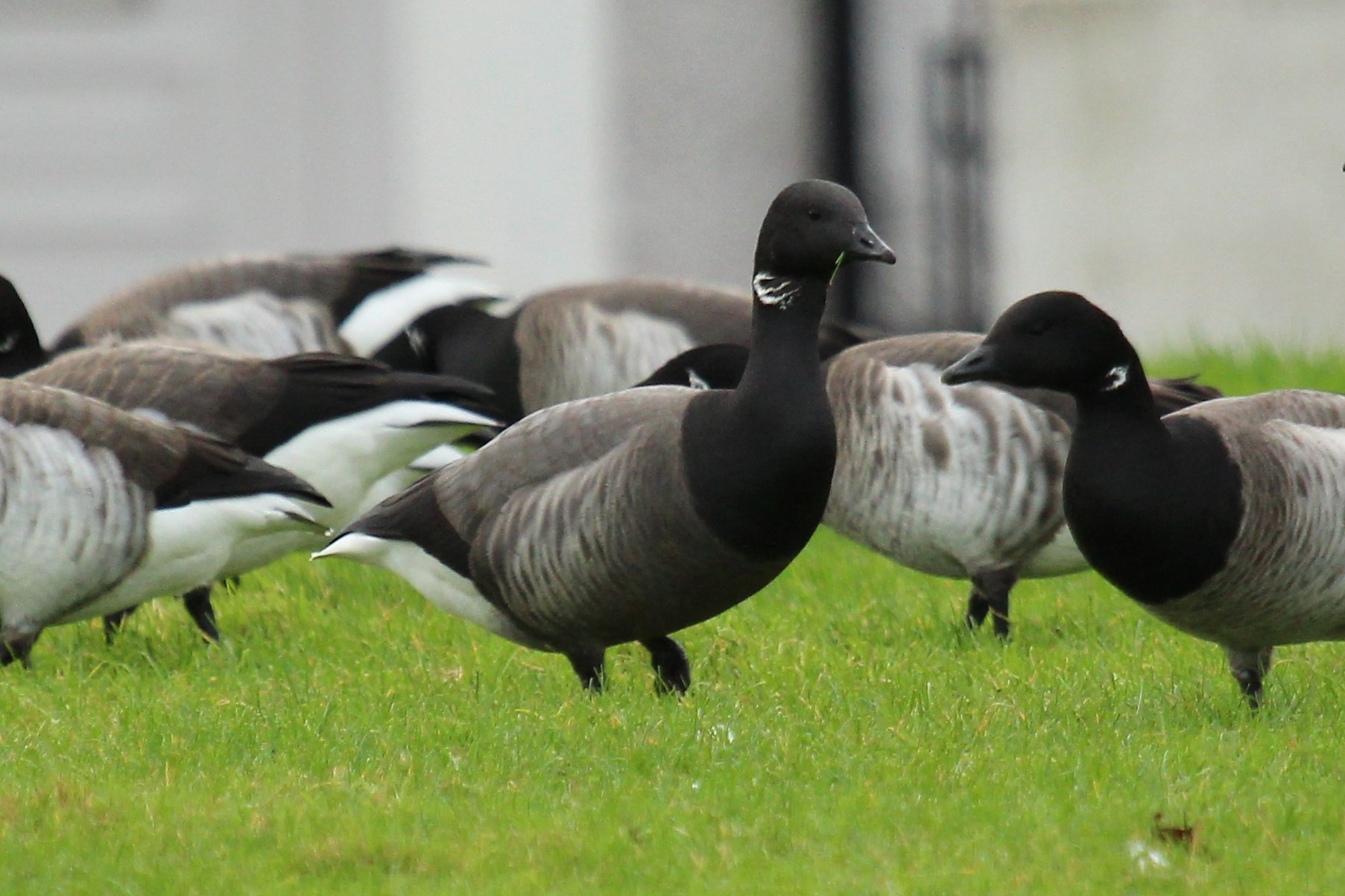
Adult Dark-bellied with pale-bellied flock - Jan Rod
This adult dark-bellied is not quite as dark brown on the underparts as the above adult. Though never the less is still quite a striking bird. That can be identified by its darker grey/brown upperparts, chocolate brown breast, belly and under-tail coverts. This particular bird shows a paler area on the flanks than the above adult. This individual is a more typical type that most Irish birders would be accustomed to. On this image, it is still evident that the brown extends from the belly right down to the under-tail coverts.

Adult Dark-bellied brent - Jan Rod
An adult dark-bellied brent in among a flock of pale-bellied. In the strong sunlight this dark-bellied still stands out from its paler counterparts. In this strong light some of the pale-bellied birds appear quite dark above this can be cause for confusion when watching brent on days like this.

Adult Dark-bellied brent in flight with Pale-bellied (background) - Victor Caschera
Adult Dark-bellied in flight with a pale-bellied flock. A nice comparison shot with pale-bellied in the background. In the strong sunlight the brown wash is still distinctive and running through the flanks. Some pale-bellied can appear quite dark grey/brown on the under-parts when in flight in either dull or bright lighting.

Adult Pale-bellied (left) adult Dark-bellied (right) - Victor Caschera
A perfect comparison image of pale and dark-bellied brent side-by-side. The chocolate brown underparts of the dark-bellied are very striking compared to the pale-bellied (left). Also note the upper-part tone between both races. The darker brown/grey dark-bellied and the scaly more greyish tone of the pale-bellied.

Adult Dark-bellied brent - Victor Caschera
Same adult as above. Showing a greyish sheen to the upper-parts in strong sunlight. While the underparts and flanks remain light brown. This particular individual shows a brown wash to the flanks (This, as mentioned above can vary from each individual).

Adult Dark-bellied brent - Jan Rod
An adult dark-bellied brent in among a flock of pale-bellied. In the strong sunlight this dark-bellied still stands out from its paler counterparts. In this strong light some of the pale-bellied birds appear quite dark above this can be cause for confusion when watching brent on days like this.
Adult Dark-bellied brent in flight with Pale-bellied (background) - Victor Caschera
Adult Dark-bellied in flight with a pale-bellied flock. A nice comparison shot with pale-bellied in the background. In the strong sunlight the brown wash is still distinctive and running through the flanks. Some pale-bellied can appear quite dark grey/brown on the under-parts when in flight in either dull or bright lighting.
Adult Pale-bellied (left) adult Dark-bellied (right) - Victor Caschera
A perfect comparison image of pale and dark-bellied brent side-by-side. The chocolate brown underparts of the dark-bellied are very striking compared to the pale-bellied (left). Also note the upper-part tone between both races. The darker brown/grey dark-bellied and the scaly more greyish tone of the pale-bellied.
Adult Dark-bellied brent - Victor Caschera
Same adult as above. Showing a greyish sheen to the upper-parts in strong sunlight. While the underparts and flanks remain light brown. This particular individual shows a brown wash to the flanks (This, as mentioned above can vary from each individual).
Grey-bellied Brant (Brent) Goose:
A subspecies that little is documented about. Though with sightings becoming more regular this race of brant is now much talked about by interested watchers. Breeding in high arctic Canada, this goose is a rare vagrant to Britain and Ireland. Most records occurring in Ireland due to this birds range. Mostly found mixing with pale-bellied brent. Juvenile/First-winters are rarely documented in Ireland and the UK. This is likely due to the lack of knowledge of this age group and the variations within pale-bellied, plus hybrids. More to be discovered!
Key Features:
First-winter: Similar to some pale-bellied brent with darker upper-parts, and grey washed under-parts, cleaner flank patch on many. Neck collar more striking often than in pale-bellied.
Adults: Many birds show a broad black brant collar (Though some, presumably females show a thinner collar), grey/brown under-parts (Darker than Dark-bellied), white flank area with a grey wash, upper-parts are dark-bellied like.
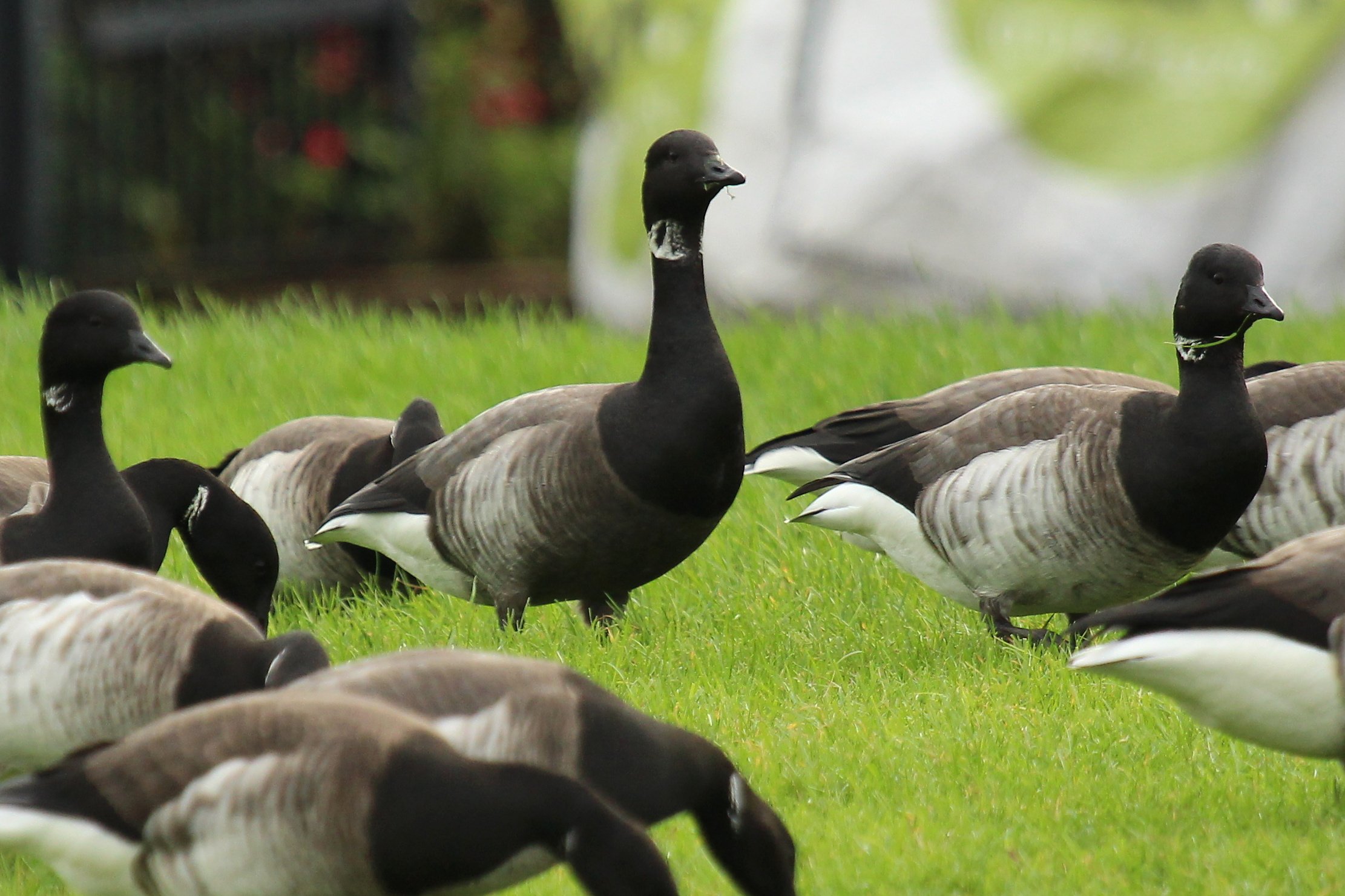
Adult Grey-bellied Brant (Brent) - Jan Rod
This adult grey-bellied type was photographed with a flock of pale-bellied and a single dark-bellied in Co. Dublin, Ireland. This individual shows a mix of features which include; Broad but broken neck collar (Broken unlike an adult black brant), dark grey/brown wash to the breast and belly, with whiteish flanks with strands of grey/brown streaking, this wash extending into the under-tail coverts. The upper-part tone is very similar to that of a dark-bellied.
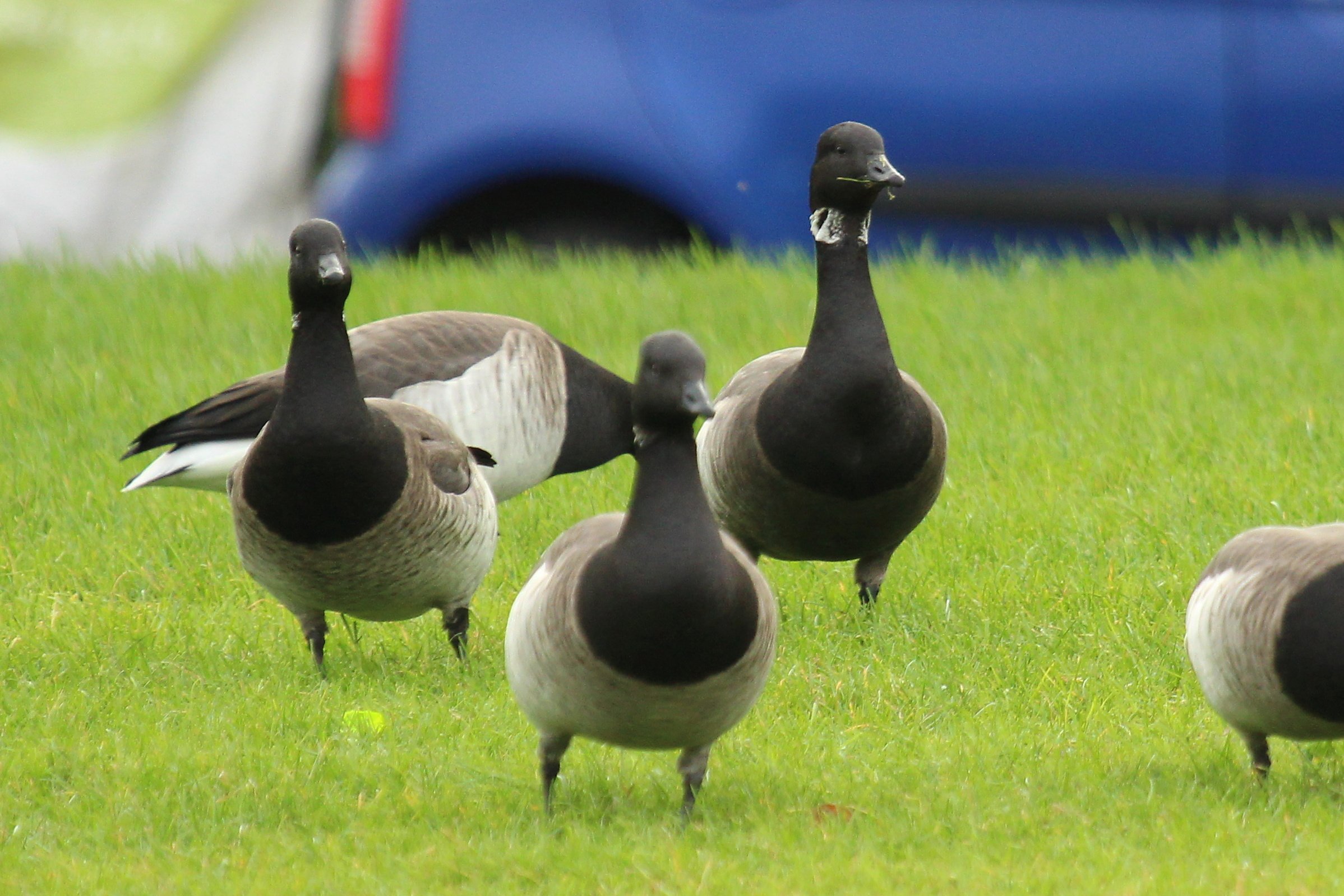
Same adult Grey-bellied as above - Jan Rod
Same adult as above. This image shows the strong difference of the belly colour between both the grey and pale-bellied subspecies. The collar on this particular bird is very brant like (This bird could quite easily misidentified as a black brant), the collar can be seen well from the face on angle and the fact that it is broken is a good indication that this bird is not a black brant.
Adult Grey-bellied brant - Victor Caschera
Again a broad neck collar, though broken, a lighter greyer/brown wash to the breast and belly compared to Jan's above bird. Upper-part tone between pale-bellied and dark-bellied.
Adult Grey-bellied brant - Victor Caschera
The Broad neck collar is a key identification feature on this adult male Grey-bellied brant. While searching through a large flock of pale or dark-bellied brent, this bird would be striking if even seen from the neck and upper-parts. As a pure pale or dark-bellied is highly unlikely to show such a prominent neck collar (Though some hybrids may show this feature)

Adult Grey-bellied brant - Steve Ganlett
Black Brant:
This is a rare vagrant from North America that was once a regular winter visitor. Though, now has since become a very rare vagrant. This is the darkest subspecies of the brent goose family. This subspecies often interbreeds with both the pale and dark-bellied races.
Key Features:
First-winter: Darker upper and under-parts than pale and dark-bellied (Under-parts tone more typical of a dark-bellied as juv/1w. Scally upper-parts, collar begins to form.

Adults;
Key Features:
First-winter: Darker upper and under-parts than pale and dark-bellied (Under-parts tone more typical of a dark-bellied as juv/1w. Scally upper-parts, collar begins to form.
First-winter Black Brant - Steve Ganlett
Upper-parts rather similar to pale-bellied, though darker, collar can be seen becoming more prominent, brown washed under-parts running into the vent, white flank patch.
Upper-parts rather similar to pale-bellied, though darker, collar can be seen becoming more prominent, brown washed under-parts running into the vent, white flank patch.
Adults;
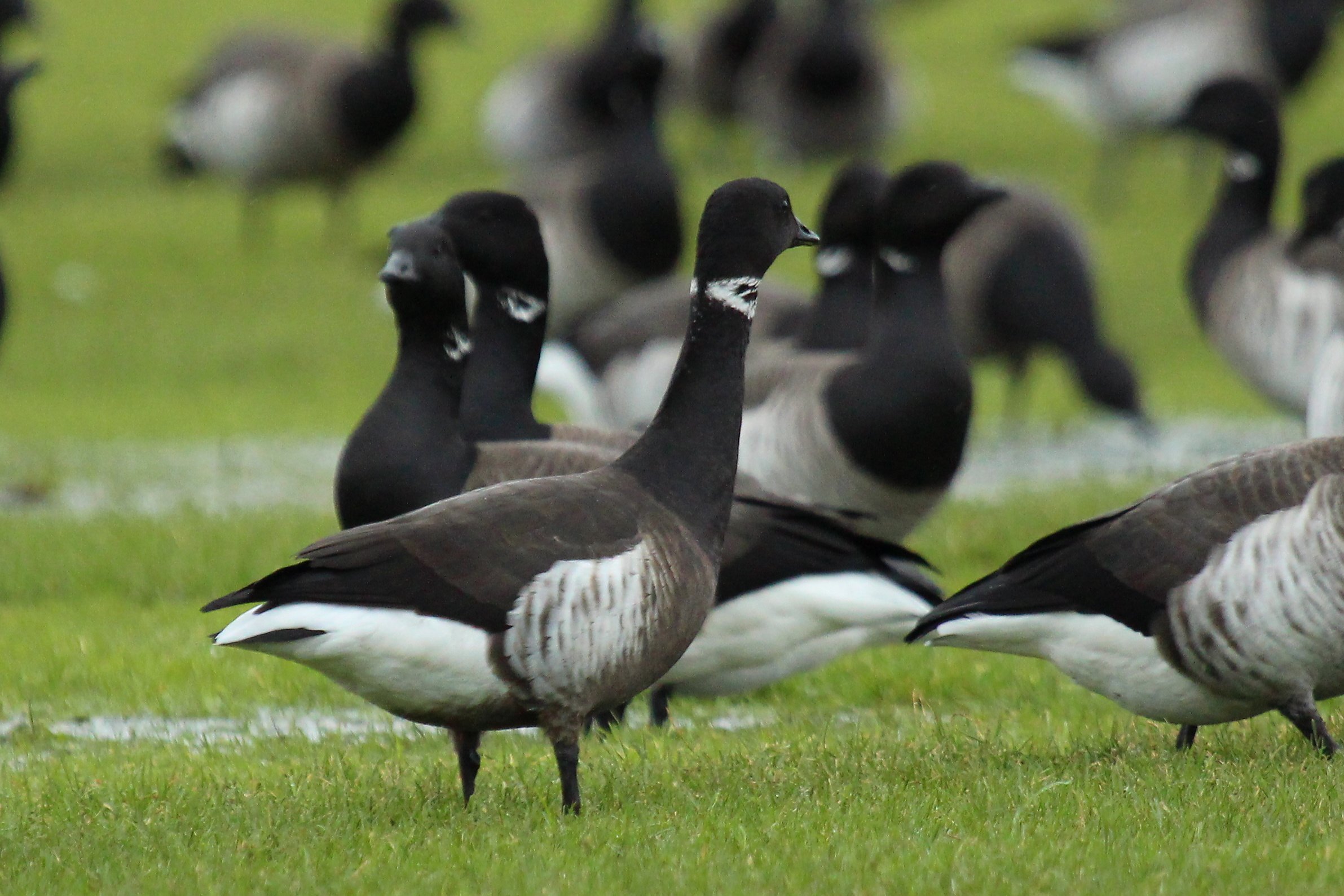
Adult Black Brant - Jan Rod
This adult black brant is striking even when seen from the back due to its strong white neck collar, dark upper and under-parts to a dark or grey-bellied.
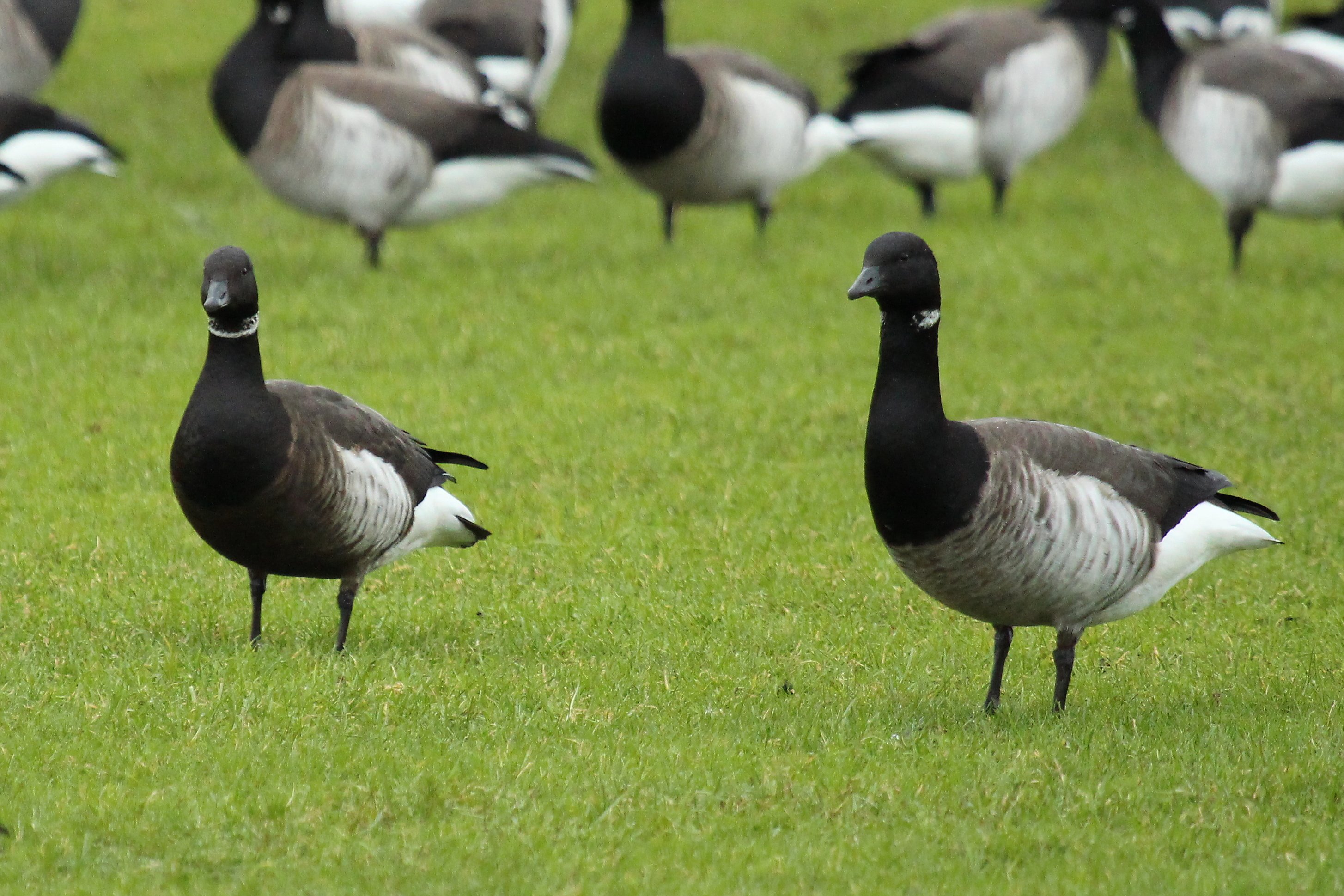
Adult Black Brant (left) and Pale-bellied brent (right) - Jan Rod
Dark upper-parts compared to pale-bellied (right), less contrasting colour between the neck and breast, clean white flanks, broad neck collar.
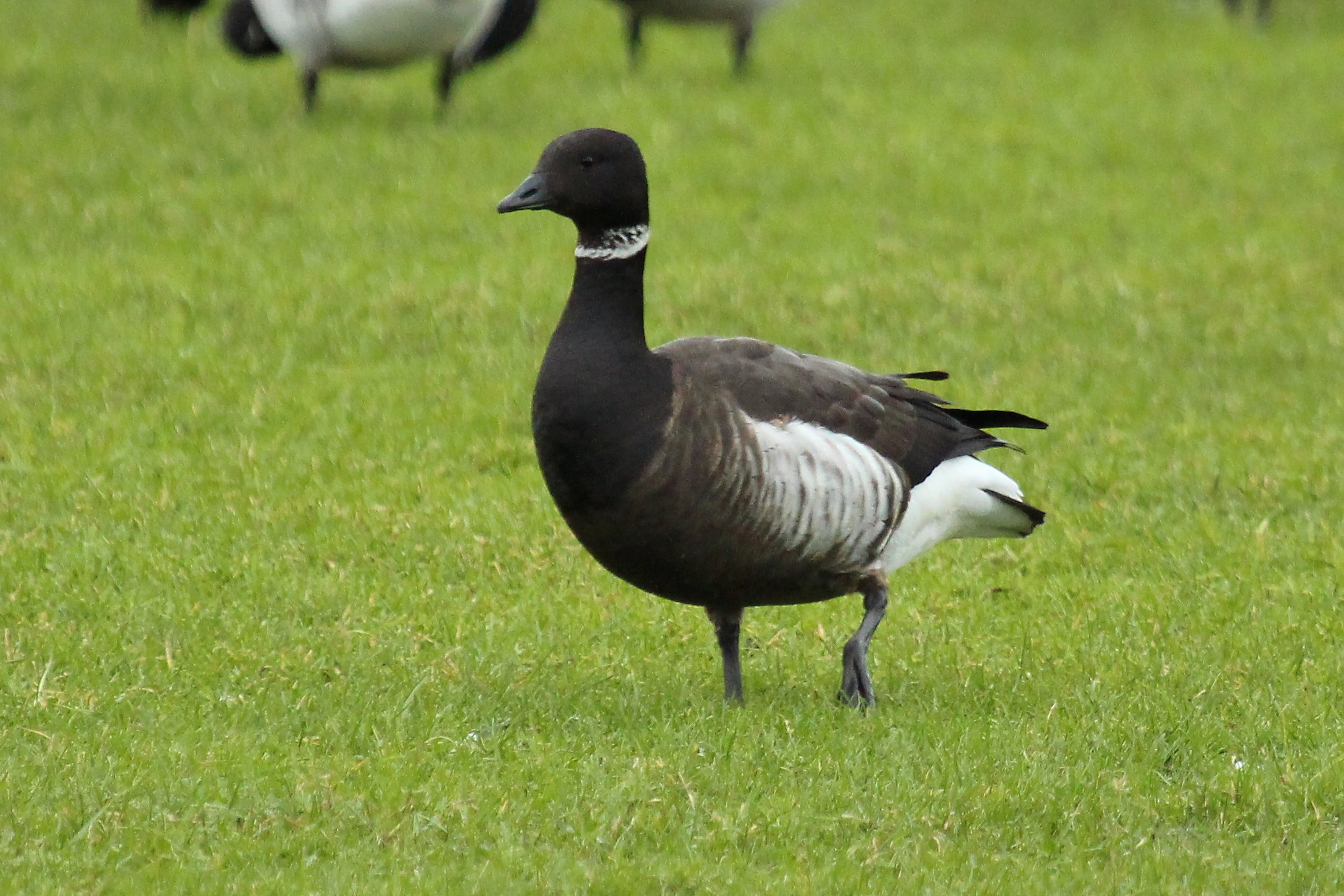
Adult Black Brant - Jan Rod

Pale,dark-bellied and black brant - Steve Ganlett

Adult Black Brant - John Miller
The contrast between the black belly and under-parts is always quite a striking feature on the black brant. (Though both pure and hybrid birds can show is). This bird shows a classic broad collar which indicates that this individual is a pure brant. The upper-parts are also dark brown with grey hues. The upper-part tone is dark than that of a dark-bellied brent. The closest race of brent to the black brant upper and under-part tone is the grey-bellied brent.

Adult Black Brant (left) and adult Dark-bellied Brent (right) - John Miller
A perfect comparison image that shows the differences in both adult black brant and dark-bellied. Adult black brant (left) showing a typical dark, almost black upper and under wing appearance, dark brown/black under-parts, black head and neck, with a broad neck collar which is still striking in flight. The white flanks compared to the brown washed of the dark-bellied are also a eye-catching feature even in flight.

Adult Black Brant - John Miller
This side on image shows the classic broad collar, which is connected at the front (Most hybrids show a broken collar), (Striking compared to pale and dark-bellied). The black running from the head and neck continues down into the belly. There is little contrast between theses areas compared to the dark-bellied.

Adult Black Brant among Pale-bellied brent - Mark Carmody
An adult Black brant feeding among a flock of pale-bellied brent at the Wexford wildfowl reserve. This image represents the true darkness of the brant compared to the pale-bellied birds. The upper-part tone almost appears black in this image (This can vary in different lighting scenarios). The dark brown/black breast and belly are contrasted with the white flanks. This brown/black extends to the under-tail coverts. The collar is also striking even in a hunched position.

Adult Black Brant - John Miller

Adult Black Brant and Dark-bellied brent - John Miller
This bird is a ideal individual to find in a large flock of either pale or dark-bellied brent. This is a typically dark bird, brown/black upper and under-parts, with the under-part brown/black running through into the under-wing coverts, stringing white neck collar.

Adult Black brant - Steve Ganlett
This image just represents the dark under-parts of a true brant. The dark under-wing is typical of a brant compared to the browner tones of a pale or dark-bellied brent. Clean white flank patch lacking a brown wash that would be found on a dark-bellied.

Adult Black Brant - Steve Ganlett

Adult Black Brant (left) Dark Bellied brent (right) - Steve Ganlett
A perfect side-by-side image that shows the key features that separate the black brant and dark-bellied brent.

Adult Black Brant in flight - Craig Holden
A classic adult black brant in flight showing the dark under-parts (must darker than that of dark or grey-bellied), clean flank area, dark (blackish) under-wing coverts compared to light brown on pale and dark-bellied, broad neck collar is striking even when seen in flight,

Adult Black Brant in flight - Steve Ganlett
And again, striking neck collar, dark under-parts, white flanks, dark under-wing all classic features of a black brant.
This adult black brant is striking even when seen from the back due to its strong white neck collar, dark upper and under-parts to a dark or grey-bellied.

Adult Black Brant (left) and Pale-bellied brent (right) - Jan Rod
Dark upper-parts compared to pale-bellied (right), less contrasting colour between the neck and breast, clean white flanks, broad neck collar.

Adult Black Brant - Jan Rod

Pale,dark-bellied and black brant - Steve Ganlett

Adult Black Brant - John Miller
The contrast between the black belly and under-parts is always quite a striking feature on the black brant. (Though both pure and hybrid birds can show is). This bird shows a classic broad collar which indicates that this individual is a pure brant. The upper-parts are also dark brown with grey hues. The upper-part tone is dark than that of a dark-bellied brent. The closest race of brent to the black brant upper and under-part tone is the grey-bellied brent.

Adult Black Brant (left) and adult Dark-bellied Brent (right) - John Miller
A perfect comparison image that shows the differences in both adult black brant and dark-bellied. Adult black brant (left) showing a typical dark, almost black upper and under wing appearance, dark brown/black under-parts, black head and neck, with a broad neck collar which is still striking in flight. The white flanks compared to the brown washed of the dark-bellied are also a eye-catching feature even in flight.

Adult Black Brant - John Miller
This side on image shows the classic broad collar, which is connected at the front (Most hybrids show a broken collar), (Striking compared to pale and dark-bellied). The black running from the head and neck continues down into the belly. There is little contrast between theses areas compared to the dark-bellied.
Adult Black Brant among Pale-bellied brent - Mark Carmody
An adult Black brant feeding among a flock of pale-bellied brent at the Wexford wildfowl reserve. This image represents the true darkness of the brant compared to the pale-bellied birds. The upper-part tone almost appears black in this image (This can vary in different lighting scenarios). The dark brown/black breast and belly are contrasted with the white flanks. This brown/black extends to the under-tail coverts. The collar is also striking even in a hunched position.

Adult Black Brant - John Miller

Adult Black Brant and Dark-bellied brent - John Miller
This bird is a ideal individual to find in a large flock of either pale or dark-bellied brent. This is a typically dark bird, brown/black upper and under-parts, with the under-part brown/black running through into the under-wing coverts, stringing white neck collar.
Adult Black brant - Steve Ganlett
This image just represents the dark under-parts of a true brant. The dark under-wing is typical of a brant compared to the browner tones of a pale or dark-bellied brent. Clean white flank patch lacking a brown wash that would be found on a dark-bellied.
Adult Black Brant - Steve Ganlett

Adult Black Brant (left) Dark Bellied brent (right) - Steve Ganlett
A perfect side-by-side image that shows the key features that separate the black brant and dark-bellied brent.

Adult Black Brant in flight - Craig Holden
A classic adult black brant in flight showing the dark under-parts (must darker than that of dark or grey-bellied), clean flank area, dark (blackish) under-wing coverts compared to light brown on pale and dark-bellied, broad neck collar is striking even when seen in flight,
Adult Black Brant in flight - Steve Ganlett
And again, striking neck collar, dark under-parts, white flanks, dark under-wing all classic features of a black brant.
I hope this identification piece is helpful to goose lovers and beyond. Over the past couple of years I have had a very keen interest in the brent/brant complex. Even when on a twitch I will spend time searching through large brent flocks along the Irish coastline looking for dark and grey-bellied and black brant. Some birders seem to think this is boring, though I find it quite satisfying and educational. I will delve into hybrid brent and brant at some stage in the near future after more studies.I would also like to thank the various photographers that have kindly let me use their images for this piece. And for the insights into the brent complex from fellow birders. I will continue to work on the brent/brant complex for many years to come, and add to these identification papers.
#Brent #Brant #Wildfowl #Vikingoptical #BirdGuides #Iirshbirder


No comments:
Post a Comment